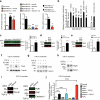Excess TGF-β mediates muscle weakness associated with bone metastases in mice
- PMID: 26457758
- PMCID: PMC4636436
- DOI: 10.1038/nm.3961
Excess TGF-β mediates muscle weakness associated with bone metastases in mice
Abstract
Cancer-associated muscle weakness is a poorly understood phenomenon, and there is no effective treatment. Here we find that seven different mouse models of human osteolytic bone metastases-representing breast, lung and prostate cancers, as well as multiple myeloma-exhibited impaired muscle function, implicating a role for the tumor-bone microenvironment in cancer-associated muscle weakness. We found that transforming growth factor (TGF)-β, released from the bone surface as a result of metastasis-induced bone destruction, upregulated NADPH oxidase 4 (Nox4), resulting in elevated oxidization of skeletal muscle proteins, including the ryanodine receptor and calcium (Ca(2+)) release channel (RyR1). The oxidized RyR1 channels leaked Ca(2+), resulting in lower intracellular signaling, which is required for proper muscle contraction. We found that inhibiting RyR1 leakage, TGF-β signaling, TGF-β release from bone or Nox4 activity improved muscle function in mice with MDA-MB-231 bone metastases. Humans with breast- or lung cancer-associated bone metastases also had oxidized skeletal muscle RyR1 that is not seen in normal muscle. Similarly, skeletal muscle weakness, increased Nox4 binding to RyR1 and oxidation of RyR1 were present in a mouse model of Camurati-Engelmann disease, a nonmalignant metabolic bone disorder associated with increased TGF-β activity. Thus, pathological TGF-β release from bone contributes to muscle weakness by decreasing Ca(2+)-induced muscle force production.
Figures






References
-
- Fearon KC, Glass DJ, Guttridge DC. Cancer cachexia: mediators, signaling, and metabolic pathways. Cell Metab. 2012;16:153–166. - PubMed
Publication types
MeSH terms
Substances
Grants and funding
- R01 HL061503/HL/NHLBI NIH HHS/United States
- R01CA69158/CA/NCI NIH HHS/United States
- R01 CA069158/CA/NCI NIH HHS/United States
- R01AR063943/AR/NIAMS NIH HHS/United States
- T32 HL120826/HL/NHLBI NIH HHS/United States
- U01 CA143057/CA/NCI NIH HHS/United States
- R01 HL102040/HL/NHLBI NIH HHS/United States
- T35 HL110854-01/HL/NHLBI NIH HHS/United States
- R01 AR060037/AR/NIAMS NIH HHS/United States
- R25NS076445/NS/NINDS NIH HHS/United States
- T35 HL110854/HL/NHLBI NIH HHS/United States
- R01AR060037/AR/NIAMS NIH HHS/United States
- R01HL102040/HL/NHLBI NIH HHS/United States
- U01CA143057/CA/NCI NIH HHS/United States
- R01HL061503/HL/NHLBI NIH HHS/United States
- R21CA179017/CA/NCI NIH HHS/United States
- R25 NS076445/NS/NINDS NIH HHS/United States
LinkOut - more resources
Full Text Sources
Other Literature Sources
Medical
Molecular Biology Databases
Miscellaneous

